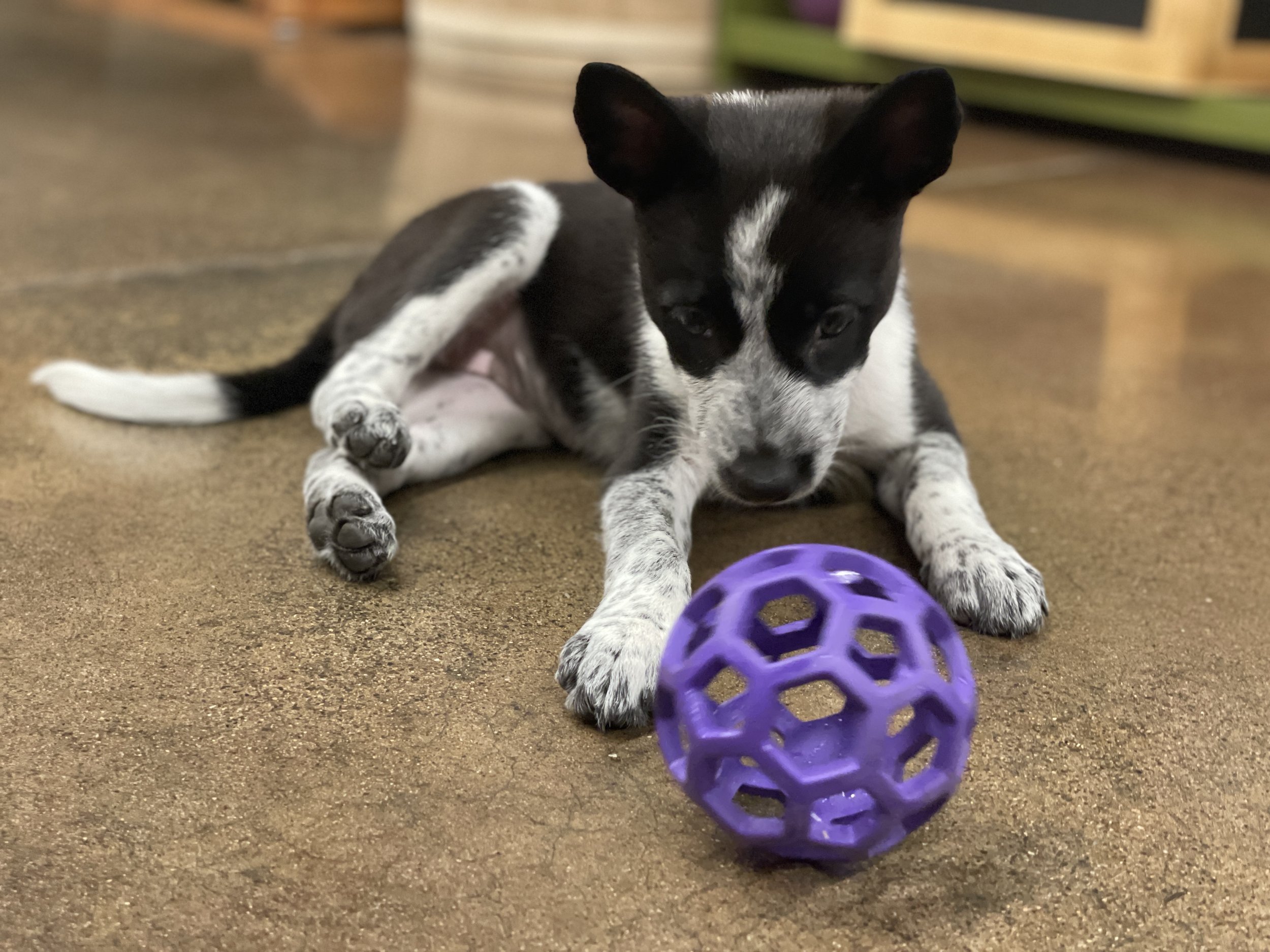Puppy Developmental Stages
Prenatal or Gestational Period: conception to birth
Even in the womb, important things are happening
What the mother experiences while pregnant can have lasting impact on the behavior of her puppies
Stress hormones can be passed to the puppies in utero
Mom’s diet and stress levels will have a big impact on the pups
Neonatal Period: birth - 13 days
Puppies are born blind and deaf and depend solely on their mother for survival.
They cannot maintain their own body heat and will need their mother to keep them warm.
The mother will stimulate the puppies to urinate and defecate and will clean up after them.
The puppies are rapidly growing and are mostly eating and sleeping during this stage.
They will use the grain of mom’s fur to help them find a teat
They begin crawling and tossing their head around at this stage
Maternal care of puppies has a big impact on puppies at this stage. More dutiful mothers create more social puppies.
Colostrum is full of antibodies to help puppies stay healthy
Transitional Period: 13 - 21 days
Puppies are starting to develop fine motor skills, awareness of things, and interest
They can now regulate their temperature, see and hear, and urinate/defecate on their own
Their eyes are open now, but the retinas are not fully developed so they only see shadows
Ears are starting to open but are not fully developed
They are beginning to become more independent as they develop awareness of their surroundings
They become much more vocal and will vocalize when they are in pain or isolated
Socialization or Sensitive Period: 3 - 12 Weeks
Puppies will happily approach novel people, animals, and objects. They are very curious about their surroundings.
The easiest time for a puppy to build a strong bond with humans and other animals
Cortisol levels peak between 8-10 weeks
Puppies have extra neurons in their brains during this time. This is the period where the most learning takes place. The brain is rapidly developing and growing, and puppies are most open to new experiences during this time.
Dr. Ian Dunbar recommends puppies meet 100 new people by 12 weeks of age for the best chance at preventing aggression as an adult dog.
Littermates and mom are teaching the puppies about appropriate play and bite inhibition. They’re beginning to develop social skills, explore social boundaries, and improve physical coordination. They’re developing frustration tolerance and developing social hierarchy through play.
Preadolescence: 13 - 18 weeks
The socialization period is over, and puppyhood is coming to an end. If a puppy wasn’t socialized adequately, problem behavior may emerge during this time.
Puppies are starting to learn their place and status within the household (both humans and animals). They want to know who sets the rules, who they need to listen to, who they can boss around, etc.
Bossy or pushy behavior emerges as they explore and push social boundaries.
Teething and destructive chewing will start, as puppies lose baby teeth and break in adult teeth.
Soft puppy fur will give way to coarser adult fur, usually starting in a strip down the back.
Puppies will become more independent and confident and will feel more comfortable being away from their owner.
A puppy's natural curiosity and desire to greet everything may be replaced with cautiousness and reluctance to approach new things.
“Expect your puppy’s personality to change as they advance through their developmental stages. ”
Adolescence: 18 weeks - 24 months
A very rough time for most dog owners and a common age for dogs to be rehomed.
Adolescence will end sooner for smaller breeds (around 9-12 months) and last longer for larger breeds (18-24 months).
Trapped between puppyhood and adulthood, dogs are full of hormones and energy. Even well-trained puppies may turn into monsters during adolescence.
Sexual maturity will be reached. Female dogs will go into heat if not spayed, at anywhere from 6-12 months of age.
Both males and females will start urine marking, and males will start lifting their legs to get the urine higher.
As dogs breaks in their new adult molars (the back teeth and last to emerge), they'll go through a second, more intense, chewing stage.
There may be an increase or emergence of aggressive or reactive behavior. It's common for adolescent dogs to bark or growl at other dogs, new people, or even inanimate objects during this time. If this is sporadic and random, it’s less concerning. If it’s constant and consistent, you need to find a trainer.
This is often when breed-specific behaviors emerge. It can be when we see German shepherds become territorial, border collies begin to chase bikes, bully breeds start to enjoy a good fight with another dog, livestock guardian breeds start to become defensive and protective of their space, etc. Genetics are often “activated” in adolescence.
Dog-dog play may become more intense and rowdy as hormones are raging and dogs are jockeying for status. This is the time when some dogs realize how fun it is to scrap with another dog, so closely monitor and potentially limit dog-dog play. Adult dogs may not be tolerant of adolescent rudeness, and puppies will likely be overwhelmed by an adolescent dog.
Your adolescent dog will be full of energy and not very obedient. This is the time of conflict within the family, which generally makes it easier for the adolescent to leave the family and set out on their own. They may be vocal and pushy, jumping and biting and chewing your things, starting fights with other dogs, getting kicked out of daycare, and generally ignoring everything you say.





